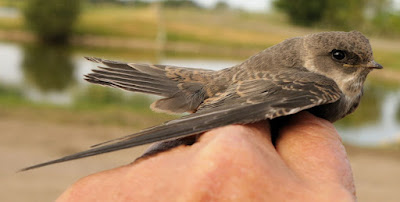On Friday the catching and ringing of Sand Martins didn’t go too well; but then in 10 years of working this quarry site, a morning often doesn’t go to plan when Sand Martins have alternative ideas to combine with their instincts for survival. Before this latest visit and since 2015 we had caught 997 Sand Martins here, not a huge number considering that in most years the colony can hold up to 400 individuals on any given day at peak periods April to August.
The quarry and its exposed face is of varying degrees of often loose material – sand, gravel and stones of all shapes and sizes where the returning Sand Martins excavate in situations that suit their own requirements rather than those of bird ringers. Mostly the birds choose a high elevation to minimise disturbance and to deter predators.
This year’s nesting chambers are high on the quarry face. The positioning of the holes is such that the ground yards below and upon which we have to erect nets is treacherous underfoot and not ideally placed to catch many of the 250+ martins returning to or leaving the nest holes some 20 yards above. Sand Martins also have incredible eyesight that combines with their unerring accuracy to fly above, below or parallel to a mist net placed to intercept a flight path.
After three hours we called it a day but delighted in just 5 new Sand Martins to take us over 1000 captures here. Hard work but someone has to do it. The bonus is a few photos when the martins rest up between bouts of hawking insects from the surrounding farmland.
We had visits from both Sparrowhawk and a Kestrel, the Kestrel hovering directly above the quarry face so as to spot unwary birds around entrance holes and thus vulnerable to attack rather than hiding in the darkness. The martins saw both raptors off by a noisy rush of wings and in the case of the hawk, chasing it into the near distance whilst giving out warning calls.
Kestrel
Other birds seen consisted of Buzzard, 4 Common Tern, Pied Wagtail, Grey Heron, Tree Sparrow.
Grey Heron
In other news and thought for the day I am told that the popular magic eye/ear of the Merlin App for lazy birders is not all it is cracked up to be. This piece of whizz-bang technology struggles to ID the quiet squeaky birds like Robins, Flycatchers, the Regulus family and probably others too.
Earlier this year the app caused a local frenzy by telling a user that a Blackbird was a much rarer Golden Oriole. The AI software will surely struggle with bird mimicry from species like the Common Starling, thrashers, catbirds and the aptly named mockingbirds (family Mimidae, Latin for mimic). I also doubt that the technology is advanced enough to analyse a song/call in conjunction with the relevant season of the year and/or a location's habitat so as to give useful advice or reach meaningful conclusions.
The “magical” Merlin app requires access to a user’s location and to a phone's microphone where the software employed may be more advanced than the listening device already installed, rarely turned to "off" on most Smartphones.
I know of people who take their Smartphones literally everywhere, allowing the machine to track and listen in to their sometimes very personal daily activities and conversations wherever they may be. Go to “Settings” and click your buttons to “off”, preferably "FO".
Rather than signing up to more of Google’s Big Brotherly love it may be better for budding birders to learn their birds another way. Find the bird then ID it through watching & listening in conjunction and comparison with the entries in a book?
Books, remember those?
Back Soon. Don't go away. I will be tracking you.
















































.png)




























